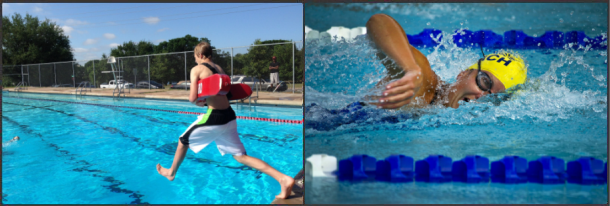Olympic swimming incorporates races with distances of 50, 100 and 200 meters races. The races will be in all of the different strokes. This includes Freestyle, Backstroke, Butterfly and Breaststroke.
Olympic swimming is called competitive swimming. In competitive swimming, the swimmers will swim various distances in each different styles. In addition to the usual styles: Backstroke, Butterfly, Breaststroke, and freestyle, there is also relay swimming.
Individual and relay medleys

The difference between individual and relay medleys is that although both have the same amount of swimming styles that must be covered, the order is different.
In Individual medley, the order is butterfly, backstroke, breaststroke and freestyle.
The butterfly is typically the most challenging stroke to manage. Thus, it makes sense to use it at the beginning when the swimmer has the most energy.
The order of the relay medley is backstroke, breaststroke, butterfly and ends in freestyle. The backstroke logically is at the beginning as it is the only swimming style that enables the swimmers to hold on to the wall. It gives swimmers extra speed as they can push away from the wall.
Rules of Olympic swimming

1. No false start
If a swimmer dives into the pool before the starting signal, they will automatically be disqualified. For most swimming events, the swimmers will be positioned on an elevated platform. With the words “on your marks,” each swimmer will be arched over their knees with the front edge of the platform in a tight grip. The starting signal will be a loud electronic beep.
Important is that the swimmer’s head is underwater within the first 15 meters.
For medley relays as well as backstroke events, the swimmers will start in the water. Underwater, on the pool wall, they will be holding a metal pole, and their feet will also be placed onto a ledge.
2. Touch of the wall
In all the different events, the swimmers always have to touch the wall when turning; this can be done with hands or feet. Either way, there must be contact with the wall; otherwise, it is the reason for disqualification. In butterfly and breaststroke, the wall must be touched with both hands. After contact with the wall, the swimmer must resurface within the first 15 meters, making a stroke.
Marathon swimming

Marathon swimming is held in open water, with varying distances, the smallest distance being 10 kilometres. It is one of the newest Olympic disciplines. It was first introduced in 2008 at the Olympics held in Beijing.
Synchronised swimming

Although this is not a race event, it still counts as one of the swimming events held at the Olympics. Synchronised swimming, which is since 2017 been renamed artistic swimming, is where, traditionally, women will perform a synchronised choreography in water. This sport is underrated as not enough appreciation is shown towards how demanding it actually is. A lot of strength, speed, coordination and flexibility are needed, all while having to be in sync and making it look effortless.
What is the best age to start swimming to become an Olympic swimmer?

If you plan for your child to be the next greatest Olympic swimmer, then the most optimal age to start would be 7-8. Some children start swimming as early as 5-6. It will take a lot of time and dedication. As with all sports, the younger you start, the better.
Olympic swimming is a big part of the Olympics, and the variety of events around it makes it all the more entertaining. The speeds at which the swimmers swim and keep making new records will forever be fascinating and admirable. Perhaps that is why it is so enjoyable to watch, as swimming is one of the sports that is actually accessible to most.

Lifeguard Services
Lifeguard services provide an easy way to hire a fully qualified lifeguard for permanent, short and long-term hire. We offer an easy way to make sure your allocated water is in safe hands. We can come to your school, outdoor event, party and more. To find out more and book, please see our booking page.




Leave a Reply